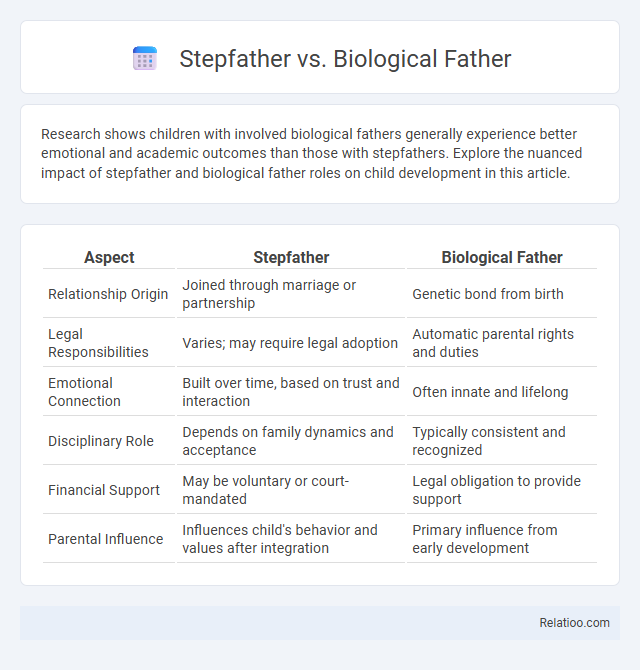Research shows children with involved biological fathers generally experience better emotional and academic outcomes than those with stepfathers. Explore the nuanced impact of stepfather and biological father roles on child development in this article.
Table of Comparison
| Aspect | Stepfather | Biological Father |
|---|---|---|
| Relationship Origin | Joined through marriage or partnership | Genetic bond from birth |
| Legal Responsibilities | Varies; may require legal adoption | Automatic parental rights and duties |
| Emotional Connection | Built over time, based on trust and interaction | Often innate and lifelong |
| Disciplinary Role | Depends on family dynamics and acceptance | Typically consistent and recognized |
| Financial Support | May be voluntary or court-mandated | Legal obligation to provide support |
| Parental Influence | Influences child's behavior and values after integration | Primary influence from early development |
Understanding the Roles: Stepfather vs Biological Father
Understanding the distinct roles of a stepfather versus a biological father involves recognizing the different emotional bonds and responsibilities each assumes within a family structure. Biological fathers have genetic and legal ties that influence child development and identity formation, while stepfathers contribute through caregiving, support, and partnership in parenting dynamics. Repartnering can reshape these relationships, requiring clear communication and role negotiation to foster stability and positive outcomes for children.
Legal Rights and Responsibilities
Biological fathers typically hold automatic legal rights and responsibilities regarding child custody, support, and decision-making, established through paternity laws. Stepfathers may gain legal rights only through formal adoption or court orders, with no automatic parental obligations unless legally recognized. Repartnering can complicate legal responsibilities, requiring clear agreements or court interventions to define custody, visitation, and financial support roles for both biological and step-parents.
Emotional Bonds and Attachment
Stepfathers often develop strong emotional bonds with children through consistent support and involvement, fostering secure attachment despite the absence of biological ties. Biological fathers typically provide a foundational sense of identity and continuity, crucial for a child's emotional development and attachment security. Your role as a repartnering parent requires patience and empathy to build trust and meaningful connections that complement, rather than replace, existing father-child relationships.
Challenges in Blended Families
Challenges in blended families often stem from navigating complex relationships between stepfathers, biological fathers, and children, requiring clear boundaries and consistent communication. Stepfathers may face difficulties establishing authority and trust while biological fathers might struggle with feelings of displacement or jealousy. Your ability to foster cooperation and mutual respect among all adults is crucial for creating a stable and supportive family environment.
Influence on Child Development
Stepfathers, biological fathers, and repartnering each uniquely influence child development through emotional support, stability, and role modeling. Biological fathers often provide a foundation of identity and genetic continuity, while stepfathers can contribute positively by fostering trust and additional emotional security when integrated well. Your child's adjustment during repartnering depends on the quality of relationships and consistent nurturing from all parental figures involved.
Navigating Parental Authority
Navigating parental authority between a stepfather, biological father, and during repartnering requires clear communication and legal understanding. Your rights and responsibilities depend on custody agreements, legal recognition, and the child's best interests, often necessitating cooperation among all adults involved. Establishing boundaries and mutual respect ensures stability and consistent parenting for the child's well-being.
Support Systems and Co-Parenting
Effective co-parenting involves clear communication and shared responsibilities between biological fathers, stepfathers, and repartnering individuals to provide stable support systems for children. Biological fathers often maintain primary legal and emotional roles, while stepfathers can offer supplementary support and nurturing, enhancing the child's well-being. Repartnering introduces complexity requiring negotiation of boundaries and cooperative engagement to foster consistent parenting approaches and minimize conflict.
Social Perceptions and Stereotypes
Social perceptions of stepfathers often involve stereotypes of lesser emotional investment compared to biological fathers, despite many stepfathers forming strong, nurturing bonds. Biological fathers are commonly idealized as primary providers and protectors, shaping societal expectations around paternal roles. Repartnering can challenge traditional family dynamics, with stereotypes sometimes casting stepfathers as outsiders or temporary figures in children's lives.
Conflict Resolution Strategies
Conflict resolution strategies between stepfathers, biological fathers, and their children focus on clear communication, respect for roles, and consistent boundaries to prevent misunderstandings. You can foster a cooperative family environment by encouraging open dialogue, acknowledging each adult's unique contribution, and prioritizing the child's emotional well-being in decision-making. Establishing shared parenting goals and employing mediation when conflicts arise help maintain harmony and promote positive relationships among all parties.
Building Healthy Father-Child Relationships
Building healthy father-child relationships involves understanding the distinct roles of a stepfather, biological father, and repartnering dynamics. Your approach should prioritize trust, open communication, and consistent support to foster emotional security for the child. Establishing clear boundaries and respect among all parental figures enhances stability and nurtures positive bonding experiences.

Infographic: Stepfather vs Biological Father
 relatioo.com
relatioo.com